| The Blue Coat School It began in 1706 as a
charity school for fifty poor boys, paid for by
subscriptions from local inhabitants. The school was
to instruct pupils in religion, reading, writing and
arithmetic.
Little seems to be known about the
school at this time, or its location. The
schoolmaster was William Geast, who was replaced by
Samuel James in 1730.
It would be some years before an actual school
was built. The report of the Charity Commissioners
in 1832, states that in 1726 “no certain settled
school house had been erected” and that it was due
to the benefactions of Samuel Taylor, that the
school was housed in Steppingstone Lane.
|
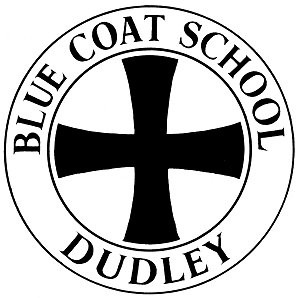 |
|
In 1726, wealthy local
landowner, Samuel Taylor, died and bequeathed ten
pieces of land in his will to Samuel and George
Bradley, who were to act as trustees and use money
from the land to form a school to educate and pay
for school uniforms for fifty poor boys. In 1738
land was purchased in Steppingstone Lane and a
school was built. There were several other
benefactors including a Mr. Ward and a Mr.
Cleveland. In later years their names were
remembered because the school’s three houses were
named after them; Cleveland House, Taylor House and
Ward House.
The original school building
consisted of two storeys, the lower floor being the
classroom, 22 feet long, by 19 feet wide and 11 feet
high. The upper floor was the school master’s
dwelling house. By the early 19th century the
building was suffering badly from mining subsidence
and had to be abandoned in about 1812.
At the time, a new school
building had recently been built in Fisher Street,
behind St. Edmund’s graveyard, where Dudley Bus
Station is today. It was built as a Sunday School at
the expense of the Blue Coat and Samuel Taylor’s
Charity. When the original building had to be
abandoned, the school moved to Fisher Street, where
a piece of land on the western side of the building
was purchased and a new extension was built.
The building had two storeys. The lower one was
occupied by the Blue Coat School and the upper room
was occupied by the Girl’s School of Industry. This
had been established in 1755 by John Hodgetts to
instruct 30 poor girls in reading, writing, sewing
and knitting.
In 1821 an infants’ school
opened on the southern side of Stafford Street, on a
piece of land between Stafford Street and
Steppingstone Street. The charity’s financial
situation was very good and both schools rarely had
less than 300 pupils between them. In 1825 an adult
school was formed in which around 40 men and women
attended classes in the infants’ school in the
evenings. In 1834 the trustees financed the building
of a school at Netherton, which was presented to the
parish.
|
The school is listed in M.
Billing’s 1855 Directory and Gazetteer of the County
of Worcester, as follows:
The Blue Coat School (Taylor's
Charity) is in Fisher Street, and was founded in
1706. Part of the funds are applied towards the
support of the Infant School in
Stafford Street, whence, at the age of seven years,
the children are transferred to
this school. It is supported by endowments and the
children's payments. Mr.
Joseph Williams, Head Master; Mr. Edward Makins,
Second Master. Average number of scholars, 200, 100 of
whom are clothed.
The Netherton
school is listed as follows:
Netherton Church of England
School, for boys and girls, is a large brick
building, well adapted for the purpose for which it
was erected; there is a house adjoining for the
master. It is supported by contribution and the
children's payments. Average number of scholars;
boys, 160; girls, 110. Mr. William Meese, Master;
Silvia Meese, Mistress. |
|
A new larger school
The financial condition of the
trust had greatly improved thanks to the purchase of
12 acres of land at Netherton in 1735. The trust
paid £170 for the land and sold the mineral rights
in 1810 for £4,000. This led to the building of a
larger school at Dixon’s Green on an unnamed road
running between Dixon’s Green Road and Blackacre
Road, which later became Bean Road. Mr Joseph Guest
provided £2,000 towards the cost, which amounted to
£2,343. The school was designed to accommodate 400
boys in two large classrooms, along with a master’s
house. The school opened on the 14th September,
1869. The girl’s school remained at Fisher Street
and the old boys’ schoolroom was rented to Miss
Steedman’s Ragged School, for 20 shillings per year.
In 1931 the Bean Road school was extended and
reorganised to become a mixed secondary school.
|
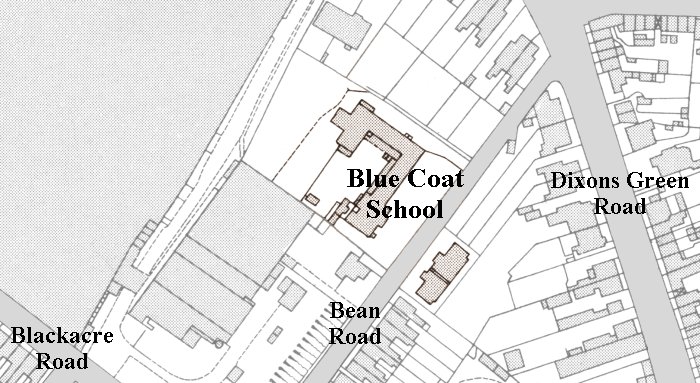
The location of the school in Bean Road.

The mixed secondary school. From an old
postcard.
| In
1936 a Handicraft and Domestic Science Block was
built on the opposite side of the road. There was
also a scheme to build a gymnasium and dining hall
next to the school, but this was shelved in 1939 at
the outbreak of war. After the war, ‘temporary’ huts
were built to accommodate extra classes when the
school leaving age was increased to 15. In 1950,
under the terms of the 1944 Education Act, the
school became a secondary modern school, with a
voluntary aided status. |

The main building in Bean Road.

The Domestic Science and Woodwork Block,
erected in 1936.
| The school had always attempted to give a free
school uniform to as many pupils as possible. The
blue uniform originally consisted of a coat and
breeches, a shirt, stockings, shoes and a cap. As
fashions changed the uniform consisted of a coat,
waistcoat and trousers. The girls in the Female
School of Industry knitted the boys’ stockings and
made the waistcoats and the lining for the trousers.
When the school was reorganised in 1932, the issue
of free clothing was discontinued. In 1955 a modern
school uniform was introduced. |

The School staff, March 1956:
Back row left to right: Mrs. J. Aitken, Mr. F. Plant,
Miss A. Smith, Miss E. Jones, Mr. J. Bloom, Miss A.
Holloway.
Front row, left to right: Mrs. M. Pearson, Mr. S.
Wright, Mr. A. W. Delacour (Headmaster), Mrs. E. Taylor,
Mr. F. Richards. |
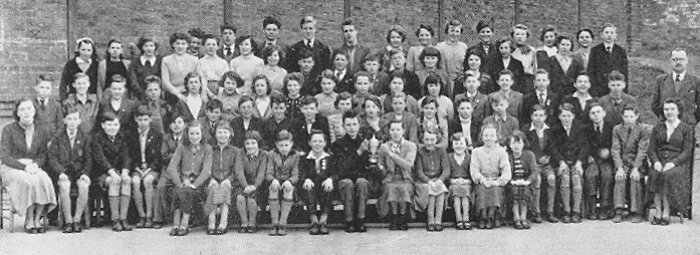
Ward House, March 1956.
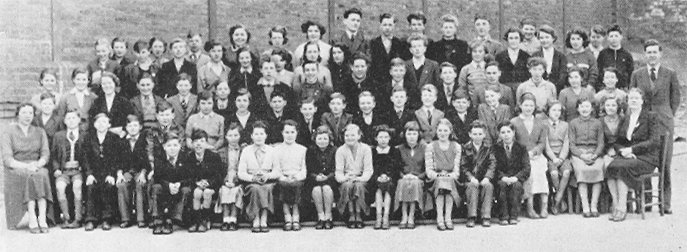
Cleveland House, March 1956.
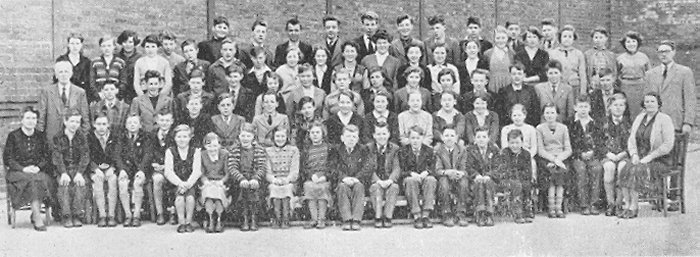
Taylor House, March 1956.
|
In 1970 the school expanded when it took over the
buildings of nearby Rosland Secondary School, in
Beechwood Road, which had closed earlier that year.
Most of the school’s activities were then centred
there, but the Bean Road site continued to be used
until 1981, when it was sold to make way for a
housing development. The school became a
comprehensive school in 1975. In the late 1980s,
Dudley Metropolitan Borough Council decided to
reorganise education in the borough and the school
was named in 1988 as one of the schools being
considered for closure. The school closed on the
14th July, 1989, with 334 pupils. It was considered
to be too small and there was no room for expansion
on the site. Younger pupils were transferred to
Castle High School to finish their education.
The buildings in Beechwood Road were demolished in
2016 to make way for a new housing development,
built around a new road called Blue Coat Drive.
Dudley Grammar School
The school was founded in 1562 when Thomas Watwood
of Stafford and Mark Rysemore of London conveyed
land, previously part of Our Lady’s Chantry, to the
churchwardens of St. Edmund’s Church and the Vicar
of Dudley, for the use of a school. A suitable
building was erected in St. Edmund’s Churchyard. The
Vicar of Dudley hoped to be the Schoolmaster, but
the job was given to Richard Baxter, who was
described as “one of England’s greatest scholars and
saints”. |
|
He was born in Rowton, Shropshire, and ordained
on the 23rd December, 1638, receiving a licence
to teach and preach by the Bishop of Worcester.
He came to Dudley at the age of 23 where he
commenced his ministry and later stated that the
people of Dudley were “a poor tractable people
lately famous for drunkenness, but commonly more
ready to hear the word of god with submission
and reformation than most places”.
In 1640 he was transferred to St. Leonard’s
Church at Bridgnorth, where his cottage still
stands.
At Dudley he composed a school hymn, which
continued to be used at the school until the
1960s. |
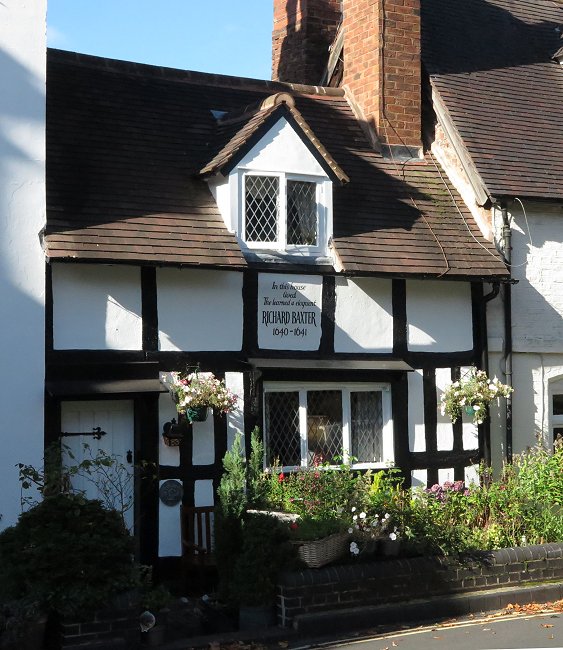
Richard Baxter's cottage
in St Leonard's Close, Bridgnorth. |
|
During its lifetime, the school moved several
times. In 1787, under the headship of Thomas
Jackson, the school was located in the north west corner of
Stone Street. Dr. Luke Booker, Vicar of Dudley,
became headmaster and hired an assistant. In
1798 the school was at Queen's Cross and had 30
pupils. Luke Booker left in 1806 and was
replaced by his assistant. The building suffered
from mining subsidence and in 1826 the school
moved to Wolverhampton Street in a property
rented from Lord Dudley. The school is listed in Pigot & Company's
Commercial Directory of 1828, as being in Wolverhampton Street. The
headmaster was
Proctor Robinson.
The building was
too small and so in 1834 the trustees purchased
a house in High Street, where the Full Moon pub
is today. At the back was a long garden that
stretched to King Street. There were several
buildings at the rear including one that was
alongside King Street. It is clearly labelled on
the 1884 Ordnance Survey map as the Grammar
School, which is listed in several directories
as being located in King Street.
|

The location of the Grammar
School in King Street. Based on the 1884 O.S. map. |
Pigot
& Company's National and Commercial Directory of
1842 has the following entry:
In M.
Billing's 1855 Directory and Gazetteer of the
County of Worcester, the listing is as follows:
From
the above listing it can be seen that the school
building alongside King Street was newly
constructed.
The school owned several
houses in High Street, Castle Street and Stoney
Lane as well as a timber yard near The Horsepool
and several plots of land on the north side of
Hall Street. In total the school owned about
three acres of land.
In
1863, Joseph Guest gave £2,000 to the school to
fund a university scholarship. In 1896 land was
offered by the Earl of Dudley in St. James's
Road. A new school building was built there with
accommodation for 160 boys, a gymnasium and a
headmaster's house. The new school opened in
1899 with an extended curriculum and a new
headmaster, Hugh Watson. |
|
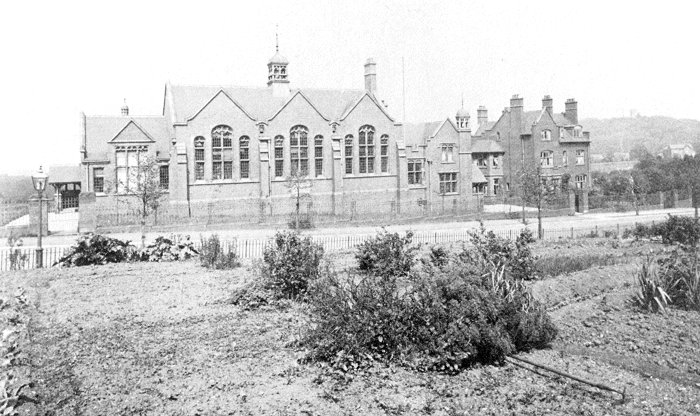
The new school in St. James's
Road. From an old postcard. |
In Kelly's 1912 Worcestershire Directory the
school is listed as follows:
| Dudley Grammar School,
St. James's Road, founded in 1562,
reorganized by the Charity Commissioners in
1879, now a secondary school
under the Board of Education; a
new building with semi-detached chemical
laboratory was opened in July, 1899.
Attached to the school is a leaving
exhibition of from £30 to £50 a year,
tenable at any university in the United
Kingdom; a gold medal is also presented
annually by the Earl of Dudley. There are
now (1912) about 130 boys: the school is
controlled by a body of governors; Hugh
Watson B.A. University of London,
Headmaster; H. M. Fraser B.A. University of
London, Second Master. Secretary, Fred Honniball, Town Hall. |
|
In 1910 the newly formed Girls High School
occupied a new building, nearby in Priory Road
and had many links with the Grammar School.
Pupils from both schools regularly carried out
drama productions and physics lessons together,
and several teachers taught at both schools.
Under the terms of the 1944
Education Act, the Grammar School became a
'controlled' school, run by the local authority.
As part of the education modernisation programme
in the 1960s, Dudley Metropolitan Borough
Council unveiled plans in 1966 for the merger of
both schools to form a mixed comprehensive
school, but nothing was done at the time. In
July 1975 Dudley Grammar School closed and
finally merged with the Girls High School and
Park Secondary School, to form The Dudley
School, which opened in September 1975.
The old grammar school building then housed
Castle High School, formed in 1989 with the
merger of The Dudley School and The Bluecoat
School. It became St James Academy in
2017 and is part of the Dudley Academies Trust.
It is also a specialist Arts College.
Dudley Girls High
School
Education changed dramatically as a result of
the 1870 Education Act that made education
compulsory for children from five to twelve
years of age. In Dudley the Grammar School
provided education for boys between the ages of
eleven and eighteen, but there was no equivalent
school for girls. Several prominent local
businessmen founded a suitable school for girls
under the name of the Dudley Proprietary School
for Girls. A suitable building was purchased on
the corner of Wolverhampton Street and Trinity
Road and the project quickly got underway. The
school opened on the 28th April, 1881 with 24
pupils, who came not only from Dudley itself but
also from neighbouring towns in Staffordshire.
Places were in
great demand and so larger premises were
acquired in St. James’s Road, which were
extended in 1896 and 1897 when a kindergarten
was added. By 1899 there were 98 pupils which
increased to 103 in 1903. In 1904 Dudley
Corporation acquired the school and it became
the Dudley Municipal High School.
The name was
changed to Dudley Girls High School when a new
school was built in Priory Road, which was
designed by J. Hutchings. The school provided
education for girls between the ages of eleven
and eighteen and as already mentioned, close
ties were formed with nearby Dudley Grammar
School.
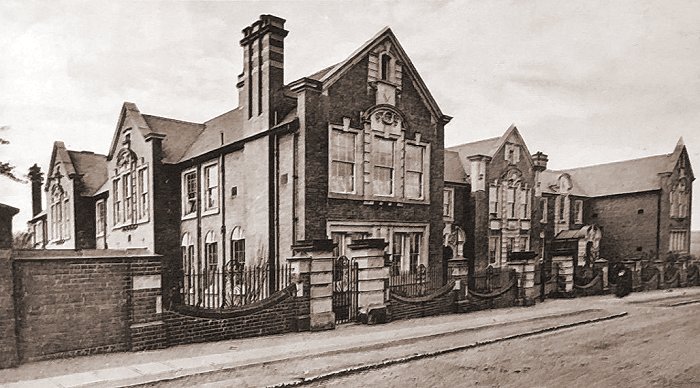
The buildings in Priory
Road. From an old postcard.
| In Kelly's 1912 Worcestershire Directory the
school is listed as follows: |
| Dudley High School for
Girls, Priory Road; Miss M. E. Burke B.A.
London, Principal. The High School for
Girls, in Priory Road, is a building of red
brick with stone dressings, erected in 1910
at a cost of about £23,000 by the
Staffordshire County and the Dudley County
Borough Education Authorities; it is
controlled by a board of 15 governors, 8
being nominated by the Staffordshire County
Council Education Committee, 6 by the Dudley
Education Committee, and 1 by Birmingham
University; Miss M. E. Burke B.A. London,
head mistress; J. M. Wynne, Education
office, Dudley, clerk to the governors. |
|
In September
1975 the school merged with the Grammar School
and Park Secondary Modern School to form The
Dudley School, initially based in the buildings
of both the former grammar school and the high
school. The Park School buildings were retained
for two years as an annexe to The Dudley School.
In September 1989, Dudley School merged with The
Blue Coat School to form Castle High School. The
school also took in pupils from the Sir Gilbert
Claughton School and the Mons Hill School, both
of which were facing closure. The building in St
James’s Road was expanded in the 1990s and the
old high school building was demolished.
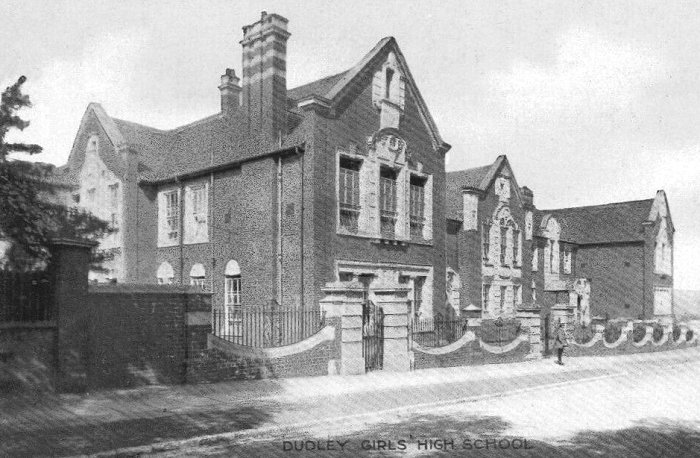
Another view of the
buildings in Priory Road. Also from an old
postcard.
|
| The Sir Gilberty Claughton School opened in 1904
in Blowers Green Road, as the Dudley Upper Standard
School. Three years late it became the Higher
Elementary School. In 1929 it became the Dudley
Intermediate School and in 1957 the Sir Gilbert
Claughton Grammar Technical School. The school was
extended for the teaching of science and it became a
comprehensive school in September 1975. By the mid
1980s student numbers were falling and the school
closed in 1990. Mons Hill School
was built off Wrens Hill Road in the early 1960s and
called Wren's Nest Secondary School. It opened in
April 1965 and became Mons Hill School in the mid
1970s. The school closed in July 1990 and was taken
over by Dudley College and later by the Wenlock
School, which caters for pupils with special needs.
Mons Hill School
was built to cater for children from Wolverhampton
Street School in Dudley, which opened in 1880 in an
area of dense housing. By the 1960s it was quite
dilapidated and closed when Mons Hill School opened.
The site was redeveloped as a public car park.
St John’s Primary
School
St John’s Primary School in St John’s Road, Kate’s
Hill, was built in 1840 along with the neighbouring
parish church. Its purpose was to educate the large
number of children from the surrounding housing
estates that catered for the large number of people
moving into the area to work in the expanding
industries. The school closed in the mid 1970s when
it merged with St. Edmund's Primary School to form
St Edmund's and St John's Primary School. The new
school was housed in a new building in
Hillcrest Road, Kate’s Hill. It is now
Beechwood CE
Primary School with the main entrance in
Beechwood Road.
St. James's School
St. James's School opened in Salop Street, Eve
Hill, in 1842. It was designed by William Bourne,
who was also the architect of St James’s Church and
St. John's Church at Kate's Hill. It consisted of a
large room, divided into two halves by a partition
that separated the boys from the girls. The main
subject was religious education. It was built from
public subscriptions and cost nearly £500. Each
pupil had to pay two pence every Monday morning, for
their weekly tuition.
In M.
Billing's 1855 Directory and Gazetteer of the
County of Worcester, the listing is as follows:
In 1868 both boys and girls were taught together
and the school mistress
was made redundant. The interior of the
school was later improved when the internal walls
were plastered and cloakrooms and heating were
added. In 1906 it became an infants school that
prepared children to be transferred to Jesson’s
Junior School.
In 1912 the school was refurbished and the weekly
charges for education were dropped. During the
Second World War, American troops used the building,
which reopened as a school after the war. In July
1972 it joined Jesson’s Junior School to form
Jesson's Middle School.
The old
school
closed in 1980 and became a youth centre until it
was declared structurally unsound in 1989. Before
the year was out, the building was taken down and
then rebuilt as an exhibit at the Black Country
Living Museum, where it was officially opened in
1992. |
|

The school at the Black Country
Living Museum on a snowy day. |
|

An interior view of the school at
the museum. |
 |
Return to the
previous page |
|